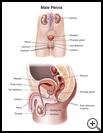
Prostatectomy
What is a prostatectomy?
Prostatectomy is surgical removal of all or part of the prostate gland. The prostate gland is part of a man's reproductive system. It is about the size of a walnut and is inside the body between the bladder and the penis. It surrounds the upper part of the urethra, the tube that carries urine from the bladder out through the penis. It makes fluid that nourishes sperm and helps carry it out of the body during sex. The nerves that control penile erection also run through the prostate.
Prostatectomy may be needed to treat an enlarged prostate that is blocking the flow of urine, for recurrent prostate bleeding, to obtain tissue to look for cancer of the prostate (called a biopsy), or for the treatment of prostate cancer.
How is a prostatectomy done?
Before the procedure:
- Your healthcare provider will ask you to sign a consent form for a prostatectomy. The consent form will state the reason you are having the procedure, what happens during the procedure, and what you may expect afterward.
- There is risk with every treatment or procedure. Talk to your healthcare provider for complete information about whether any of these risks apply to you:
- Anesthesia problems
- Bleeding
- Blood clots
- Infection
- Tell your healthcare provider if you have any food, medicine, or other allergies such as latex.
- Tell your healthcare provider if you are taking any medicines, including nonprescription drugs, herbal remedies, or recreational or illegal drugs.
- You will have a needle (IV) inserted into a vein in your hand or arm. This will allow for medicine to be given directly into your blood and to give you fluids, if needed.
During the procedure:
- You may be given a sedative through your IV to help you to relax.
- You will be given medicines to prevent pain during your surgery. These may include:
- Regional anesthesia, which numbs a large area of your body. Depending on the medicine, you may be awake or asleep during the procedure.
- General anesthesia, which relaxes your muscles and puts you into a deep sleep. It also keeps you from remembering the operation. While you are asleep, you will have a tube in your throat to help you breath and to make sure you are getting enough oxygen. The tube may be removed before you wake up after the surgery.
- Your surgeon will recommend the best surgery for you. The type of surgery you have to remove the prostate gland may be one of the following:
- Radical retropubic prostatectomy: Surgery to remove the prostate gland, tissue around the prostate gland, and the glands that make semen (seminal vesicles) through a large cut on the lower abdomen
- Laparoscopic radical prostatectomy: Surgery to remove the prostate gland, tissue around the prostate gland, and seminal vesicles through several small cuts on the lower abdomen
- Radical perineal prostatectomy: Surgery to remove the prostate gland, tissue around the prostate gland, and seminal vesicles through a cut in the perineum (the area between the scrotum and anus)
- Your provider will then close the cut with stitches or staples.
After the procedure:
- You will be checked often by nursing staff.
- Your blood oxygen level will be monitored by a sensor that is attached to your finger or earlobe.
- Your heart rate, blood pressure, and temperature will be checked regularly.
- Your surgical wound will be checked often and dressings will be changed as needed.
- You will have a catheter in your bladder to drain your urine until you are able to urinate on your own.
- Your provider may prescribe medicine to:
- Treat pain
- Treat or prevent an infection
- Treat or prevent side effects, such as nausea or constipation, from other treatments
- Your provider may recommend other types of therapy to help relieve pain, other symptoms, or side effects of treatment.
- You may have problems with erectile dysfunction or urinary control after surgery.
What can I do to help?
- You will need to tell your healthcare provider if you have new or worsening:
- Trouble emptying your bladder
- Weak flow of urine
- Increased urination
- Blood in urine
- Pain or burning when urinating
- Swelling in your scrotum or groin
- Pain or cramping in your belly
- Redness, swelling, pain, warmth, or drainage from your surgical wound
- Fever, chills, or muscle aches
- Ask questions about any medicine or treatment or information that you do not understand.
How long will I be in the hospital?
How long you will need to stay in the hospital will depend on many factors. The average amount of time to stay in the hospital after a prostatectomy is 2 to 3 days.
Last modified: 2016-07-18
Last reviewed: 2016-07-15

